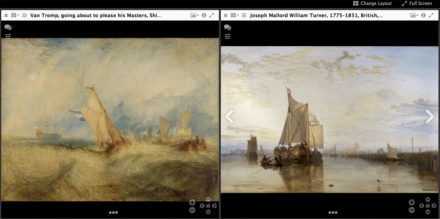Meet Melissa Gill, an art historian and library and information scientist by day and a foodie by night. She owns a comprehensive taco encyclopedia, has climbed Mount Whitney, and knows the word for metadata in French.
As a digital project manager, Melissa’s job at the Getty Research Institute (GRI) is all about establishing and maintaining access to digital assets—things like photos of a Piet Mondrian painting, the “Mondrian” record in an online library catalogue, or even the photos of photos of a Mondrian painting.
Melissa devotes most of her time to facilitating the creation and conservation of metadata about digital assets like these. Metadata is the stuff that describes data—in this case, more digital assets, such as an entry in an electronic thesaurus—to a computer.
Why Work with Metadata?
Metadata isn’t on the mind of most casual internet users, but it’s extremely important. It works behind the scenes, enabling us to search the web and various databases to find exactly what we’re looking for. Working with metadata contributes to a collective push for accessibility and transparency in the world of GLAM (galleries, libraries, archives, and museums). If an artwork or archive is digitized and put online, but no one can find it, it’s not truly accessible.
Melissa is acutely aware that art and archival objects are often inaccessible to those outside the museum walls, behind virtual paywalls, or behind socio-economic barriers. She is motivated by the goal to eliminate these impediments, using digital technologies and protocols to make cultural heritage materials more widely discoverable online. For her and others in her field, creating standardized metadata isn’t just a technology project—it’s a way to expand access and disseminate knowledge beyond virtual and physical barriers.
How She Chose This Career
Melissa has dedicated a large part of her life to galleries and museums, but she didn’t grow up frequenting them. As the creative outlier in her family, her proclivity for photography and “making” in general led her to art history. It wasn’t until college, where she was struck by contemporary art’s ability to transcend the commonplace, that she shifted her focus to studying art rather than making it.
Inspired by a galvanizing lecture about the intersections between art and technology, Melissa went on to pursue a master’s in library and information science while she worked towards her master’s in art history.

Melissa’s workspace is decorated with her favorite things—including art, taco references, and her pet bird. Photo: Marissa Clifford
What Inspires Her
Seeing Yayoi Kusama’s Fireflies on the Water at the Whitney Biennial in New York City during graduate school confirmed for Melissa that she chose the right career. “It was a piece that I carried with me for a long time,” she told me, “and still do.” An immersive, walk-in experience simulating endless space, Fireflies influenced the type of art Melissa gravitates to today—art that exhibits a sort of “intellectual whimsy,” as she calls it.
As a digital art historian, Melissa works many hours at the computer, so when she gets a chance to step outside the confines of her monitor and into the galleries of the museum, she takes it. “I try to be proactive because I’m three steps abstracted from the art, so I value seeing the physical objects.” Certainly, as important as digital surrogates are for education, dissemination, and preservation, nothing beats seeing a Mondrian or a Kusama in person.
For more convo with Melissa, see this Storify of a recent live Twitter and Instagram Q&A that covered library science, project management, her internet-famous dog-bird duo, and her life at the Getty.
Next to be profiled from the digital art history team: Nathaniel Deines, Pacific Northwest native and casual cinephile. Stay tuned.





Comments on this post are now closed.